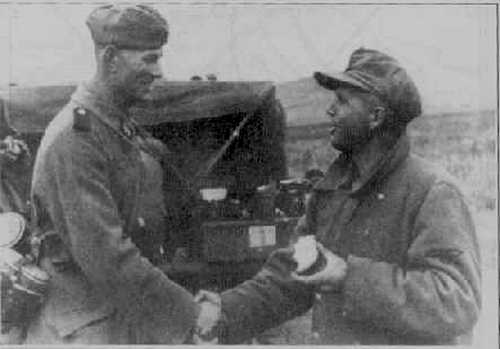
German Forces
Henk Feldmeijer at the Caucasus front
www.waffen-ss.nl
Feldmeijer (right) meets another Dutchman at the Caucasus front.
Johannes Hendrikus Feldmeijer
Johannes Hendrikus Feldmeijer was born in Assen in 1910. He was a student of mathematics and physics at the Rijks Universiteit Groningen (1928-1935), but he quit his studies in order to devote himself entirely to politics. Feldmeijer became a member of the NSB in 1932 when he was only 21 years of age. Like Meinout Rost van Tonningen he is considered to be of the 'volkse' movement within the NSB who played an important role in the organisation's radicalisation. The 'volksen', who increased their influence within the NSB in 1935, were of a Germanic and pro-German orientation. They largely derived their ideas from the racist and anti-Semitic blood and soil theory of the NSDAP. The 'volksen' idealised the rural lifestyle, the history of the Germanic ancestors, and conducted scientific research on subjects connected with these ideas.
From 1937 Feldmeijer performed an important executive function within the organisation Der Vaderen Erfdeel (from 1940: Volksche Werkgemeenschap), the 'volkse'-cultural society that performed the research in which rediscovery of the 'volkse' awareness and the separation of foreign elements from the 'volksen' were the central ideas. They made the Dutch aware of the fact that their culture was 'fundamentally Germanic', taking an important step in the direction of SS ideology. Feldmeijer was strongly attracted to this SS ideology, but was forced to stay in the background as far as his devotion to politics in the Netherlands was concerned, as the expression of such ideas was not appreciated within the NSB.
Anton Mussert, the Leider (leader) of the NSB and a supporter of the Dietse/Great-Netherlandish school of thought would have nothing to do with SS ideas. In 1939 Feldmeijer founded the Mussert-Garde together with Rost van Tonningen.
This youth organisation of the NSB - which in practice consisted entirely of young men - had a great deal in common with the SS. Its members got a political education, heavy physical exercise, and were required to meet certain racial requirements (Jews were not allowed to join). The Germans' admiration for the young Feldmeijer increased during the occupation. He had all the characteristics of an ideal SS soldier even before he was an actual member and quickly became a personal trustee of the Höhere SS- und Polizeiführer Rauter. It was therefore hardly surprising that the SS appointed Feldmeijer as the leader of the Dutch SS (the Dutch variant of the German Allgemeine SS). Feldmeijer was almost constantly involved in conflicts with Mussert as his Great-Germanic political ideas (working towards a great Germanic empire under the leadership of Adolf Hitler) constantly clashed with Mussert's Great-Netherlandish ideas.
Feldmeijer did not disappoint his SS superiors. He ensured that there was a constant flow of people from the Dutch SS (later called the Germaansche SS in the Netherlands) to the Waffen-SS. After the German attack on the Soviet Union Feldmeijer called on all true SS soldiers to report to Standarte 'Westland' ('Wiking' division) to join in the battle against bolshevism. Eventually almost the entire Dutch SS ended up serving on the eastern front. Feldmeijer himself set the 'proper' example on several occasions. He served as an gunner in the 'Leibstandarte Adolf Hitler' during the Balkan campaign. (Unterscharführer) Feldmeijer was Flak Geschützführer (commander of an anti-aircraft battery) in the 'Wiking' Division from 10 June 1942 to 1 March 1943. He was decorated with the Iron Cross second class, the Sturmabzeichen, and the Verwundetenabzeichen in black. On 1 March 1943 Feldmeijer was promoted to SS-Standartenführer in the Germanic SS (as the Dutch SS was called from 1 November 1942), as well as Untersturmführer der Waffen-SS. In September 1944 Feldmeijer played an important role in the reinforcement of the Landstorm Nederland (a unit with the status of division from 10 February 1945).
Feldmeijer tried to concentrate his 'own' SS men within the 'battalion Feldmeijer' that was to be a part of the division, which was stationed in the Netherlands and was a division only on paper, was the only 'Freiwilligen Division' to fight the western allies. On 22 February 1945 Henk Feldmeijer, who had by then been promoted to Standartenführer der Germaansche SS and Hauptsturmführer der Waffen-SS, was killed at the age of 34. The official story tells us that he was riddled with bullets by an allied fighter-bomber during a car ride near Raalte. Other sources say that Feldmeijer was shot by his own men. Although Feldmeijer was known as 'a true SS man' and was very popular with people like Heinrich Himmler, he could not resist the many temptations that came with his position. He was guilty of abusing alcohol and women on many occasions, as well as corruption during the war. For all this people within the SS wanted to get rid of him.
4296 Views
5/29/2010
